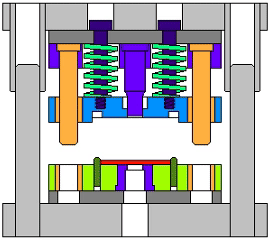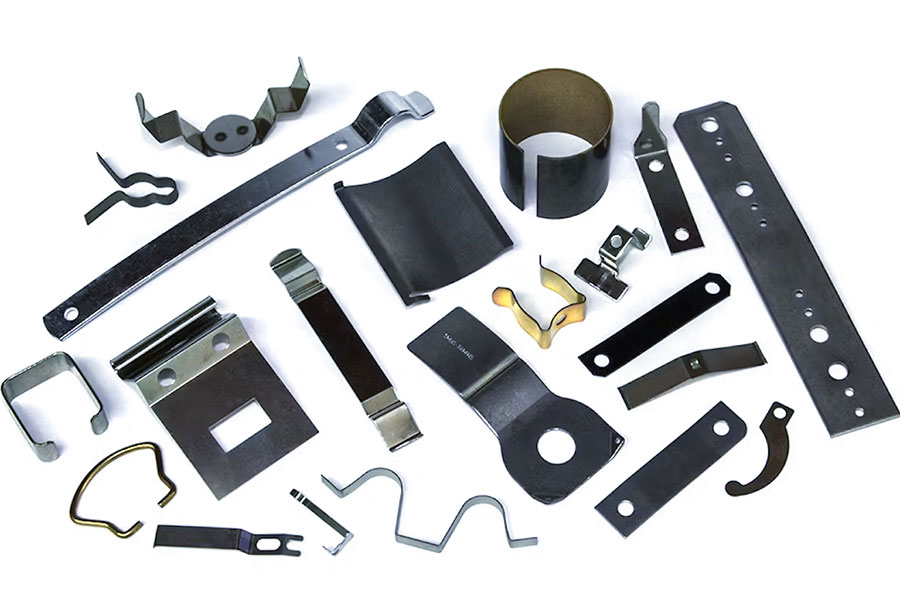精密機器のマイクロコンポーネントであろうと、産業機器の大規模な構造コンポーネントであろうと、初期段階での厳密な設計とエンジニアリング計画なしでは、金属スタンピングの優れた性能を達成することはできません。材料の選択から許容制御、金型設計からプロセスの最適化まで、すべてのステップは最終製品の品質とコストに直接影響します。
JS精密製造は、20年にわたる業界の経験を持つ、設計およびエンジニアリング段階の重要な役割を理解しています。高度な処理技術とソリューションを通じて、±0.005mmの超精密機械加工を達成することができます。
1.材料プロパティとカビ寿命 金属スタンピング材料の延性、硬度、耐摩耗性は、ダイと構造の設計の選択に直接影響します。 アルミニウムスタンピングには、接着問題を考慮し、カビ表面処理の最適化と最適化が必要です。
2.moldクリアランスとエッジの精度 金型クリアランスが大きすぎる場合、より小さすぎる場合、金型詰まりを引き起こすのは簡単です。 3.プロセスパラメーターマッチング スタンピング速度、圧力、ストロークパラメーターは、DIEデザインと協調して最適化する必要があります。 死ぬので、複数のプログレッシブダイを段階的に複雑な形状スタンピングを達成する必要がありますスプリングバックの変形を避ける。
4.耐性制御と機能要件 金属パンチの精度レベル(±0.01mm)は、ダイの耐性割り当てに直接影響します。 span class =" cente "data-translateid =" 9461f3c94262626573b27318fe data-pos = "0" data-len = "40" data-v-7b79c893 = "" "> 5.加熱処理と表面強化 窒化や真空消光などの熱処理プロセスは、ダイの硬度と靭性のバランスを決定します。 
重要な金型設計の影響要因は何ですか?
6.Demoldingメカニズム設計
demolding勾配、騎手排出位置、および指導の数を製品の形状に従って最適化する必要があります。
7.コストと大量生産要件
金型設計では、初期投資と大量生産効率の両方を考慮する必要があります。 小さなバッチ、多変量生産に適しています

スタンピングプロセスの選択においてどの設計要素を考慮する必要がありますか?
プログレッシブスタンピング:
- 利点:複雑な形状の金属スタンプに適した、多段階の連続スタンプの高精度、高精度、高精度、<
- 弱点:複数のプロセスを調整する必要があります。
- 該当するシナリオ:自動部品や電子コネクタなどの多機能統合を必要とする金属部品にスタンプします。
- 弱点:複数のプロセスを調整する必要があります。
deep d rawing:
- 利点:ディープキャビティ構造(水タンクなど)は、単一のストレッチ、単純化されたプロセスステップによって形成されます。
- 弱点:高い人種性要件、しわや亀裂が簡単、複雑な金型設計。
- 該当するシナリオ:構造部品の単純な幾何学的形状などの容器や深い空洞の金属スタンピング生産
2.シングルvs.複数のスタンピング段階
<テーブルスタイル= "境界線崩壊:崩壊;幅:100%;境界線:1px;境界線:#000000;" border = "1"> 3
以下は、エンジニアリングの特徴におけるアルミニウムの特徴とテクニカル・スタンピングの特徴とテクニカル・スタンプの特徴の主要な困難と対策です。会社: アルミニウム合金合金(6061および5052モデルなど)は優れた引張変形能力を持っています。 バック、その結果、部分サイズの偏差が生じます。 深さ。
アルミニウム合金スタンピングのエンジニアリング設計上の課題は何ですか?
次のソリューションを提供します:
- 金型設計段階で、高精度機器(精密±0.005mm)を使用します。
- 材料処理については、プロフェッショナルシミュレーションテストサービスを提供しています。 class = "entent" "data-translateid =" BB6805B1B9164E2D14E2D14ED14ED14ED14ED14ED13ED10ED13ED30F69801010FEB "data-pos =" 78 "data-len =" 116 "data-v-7b79c893 =" "> 削減すると、成形特性を改善できます。
2.表面保護と酸化防止治療
アルミニウム合金材料は、スタンピング処理に2つの主要な表面品質の問題を抱えています:
- まず、その比較的ソフトマトリックスのプロパティは、成形プロセス中に欠陥を傷つけやすくなります。
- 第二に、表面の酸化物層は塑性変形中に剥がれ、次のコーティングプロセスの接着性能 li>
これら2つのプロセスの難しさに対抗すると、プロのカビの表面強化プログラムを実装しました。 最新の表面修正技術を採用することにより、ダイヤモンドのようなカーボンフィルムコーティング(DLC)や窒化処理など、材料の摩擦係数と材料副耐性の摩擦係数を大幅に低下させるだけでなく、30%以上の寿命を強化しました。
3.発展におけるチャレン The span> high strength 7-series Aluminumium Alloys <低プラスチック変形容量 will は簡単に亀裂欠陥につながりますdata-dismiss-id = "7b69bc695e6e45a0974c54337943c69f" data-group-type = "Typos" data-group-vip = "0"> in 形成プロセス。 data-id = "495f65a2d593e3a913e016173bf12704" data-detail-type = "grammar" data-dismiss-id = "9b2d8e54da5d6a1cd9f3520e6e2b95" data-group-vip = "0"> is 従来のスタンピングに対する深刻な課題 processes
2つの新しいプロセスソリューションを作成しました:
- ホットフォーミングテクノロジーソリューション:450 マルチステッププログレッシブ形成プロセスを取得すると、マテリアルリバウンドが効果的に抑制され、寸法精度が確保されます。
- 柔軟なフォーミング制御システムを通じて、柔軟なフォーミング制御システムを通じて柔軟なフォーミング制御システムを介して、インテリジェントシステムを実現します。 当社の機器は、1分あたり1200倍のスタンピング周波数を達成でき、異なる形成プロセスに最適な圧力曲線で動作パラメーターのリアルタイム規制を可能にします。
4. old設計とコストバランス
アルミニウム合金スタンピングには、高精度のダイ(マイクロメーターレベルの特徴など)が必要ですが、複雑なダイコストは高く、小規模生産の経済的利点は低いです。
ソリューション:
- モジュラー金型設計:金型置換技術により、金型の交換時間が30分に短縮され、複数のモデルを交換できるようになり、開発コストが削減されます。
- シミュレーションドライブ最適化: jsは無料のDFMレビューレポートを提供します、金型開発サイクルの20%を節約します。
5.構造強度の紛争
autoコンポーネント体重を減らしながら衝突から安全である必要があります。
ソリューション:
- 油圧形成技術:材料の使用は、内部の高圧膨らみを介した複雑な中空構造の実現により減少します。
- パッチワーク:レーザースプライシングソリューション、異なる厚さの鋼板溶接、そしてスタンピングしてローカル強度を最適化する。
 完成品の品質に対するスタンピング速度の影響は何ですか?
完成品の品質に対するスタンピング速度の影響は何ですか?
1.品質に対するスタンピング速度の影響
<テーブルスタイル= "境界線 - 崩壊:崩壊;幅:100%;境界線幅:1px;境界線:#000000; height:279.031px;" border = "1">2.JS Companyハイテクテクノロジーソリューション
スタンピングのスマートスピード制御:
自動能力を備えたスマートサーボプレスシステムを使用して材料条件ごとにスタンピングの速度を変更し、調整可能な範囲100〜1200回/分を変更します。自動車コンポーネントの製造の例により、車両が1分あたり800回の高速でスタンプされている場合、システムは自動的に動的圧力補償を自動的に実行し、実際には製品のリバウンドレートを0.3%に維持します。
精密金型テクノロジー:
私たちの金型は、特別な埋め込み冷却チャネルを備えた埋め込み冷却チャネル構造を備えており、高速スタンピング金属によって生成された熱を効果的に制御します業界平均よりも30%長い金型の寿命。一方、ダイヤモンド様炭素(DLC)コーティング技術を使用すると、摩擦係数が減少するだけでなく、金属スタンピング部品の表面がマイクロメートルレベルの滑らかさを達成できます。
シミュレーション技術を形成する材料:
有限要素分析(FEA)シミュレーションにより、異なるスタンピング速度で材料の流れ条件を正確に予測することができ、それに応じてプロセスパラメーターを変更することができます。たとえば、アルミニウム合金材料の場合、システムは1分あたり600回以内にスタンピングの速度を制御することをお勧めします。 当社のデジタルプラットフォームは、リアルタイムプロセス調整の提案を提供します。
lntelligent品質検査システム:
高精度の青色光スキャナーを使用すると、高速スタンピング部品の寸法精度(±0.005mm検出精度)をオンラインで検査し、欠陥のある製品を自動的に拒否できます。 AIの目視検査技術により、システムは表面の傷、亀裂、その他の欠陥をリアルタイムで識別できます。
3.さまざまなアプリケーションシナリオでの速度選択のためのスガゲ
<テーブルスタイル= "境界線崩壊:崩壊;幅:100%;境界線幅:1px;境界線:#000000; height:189.469px;" border = "1"> 小規模バッチの生産に精密な処理が必要かどうかは、迅速な配信を必要とするかどうか、金属スタンピングの寸法の精度と品質の安定性を保証できます。
スタンピングマシンの論理選択は、生産効率、コスト管理、および製品品質保証を確保するための重要な考慮事項です。 With regard to the requirement for metallic stamp parts in production, the following analysis will be conducted based on the major dimensions: 1.Correlating material properties with equipment tonnage For light metal materials such as copper and aluminum, low to mid-tonnage punching machines weighing 50-200 tons should be used. This configuration is capable of addressing the needs of molding without causing waste created by material over-deformation. While dealing with high-strength steel or alloy materials, the heavy-duty stamping machines should weigh more than 800 tons. Sufficient pressure is required to ensure that the material will undergo sufficient plastic deformation during the process of stamping. For very thin sheets whose thickness is less than 0.2mm, servo presses or hydraulic presses are recommended. Such machinery can provide high speeds so that the stamping process may be controlled accurately and the tearing risk of material minimized effectively. 2.Production efficiency in batches and equipment 3.Accuracy requirement and equipment performance 4.Mold design and equipment compatibility 5.Cost-benefit analysis JS company uses intelligent control system to manage production process. They use precision molds to ensure product quality. At the same time, automated testing equipment will detect product conformity in real time. This production method can meet different needs. We can guarantee the precise size and stable quality of the metallic stamp, whether for small-scale scale production requiring fine processing or for large scale orders requiring quick delivery. 1.Electroplating 2.Chemical conversion coating 3.Anodic oxidation Oxide film is formed on the metal surface of aluminum stamp metal to improve hardness and abrasion resistance, and can be dyed to achieve a personalized appearance. JS technology association: Provides hard anodizing (film thickness up to 50 μm) combined with sandblasting technology to meet military grade wear resistance (e.g. aerospace fasteners). 4.Spraying and powder coating polymer coating is sprayed with electrostatic adsorption. It has the characteristics of heat preservation and weatherresistance, and is suitable for decoration parts such as home appliance panel. JS technology association: Fully automated spraying lines with color difference ΔE≤1.5 were used to support special effects such as matte and high gloss with 99.8% rate. 1.Core advantage of JS mold lifespan 2.Mould lifespan of JS compared to other suppliers Value to customers of JS's mold usage time: Automotive industry: 1.2 million vehicle service life, support a production line for 8 months in a row, reduce mold changes downtime. Electronics industry: Mass production stamping metal parts with micrometer level precision and long life in accordance with 0.02mm tolerances. Cost effectiveness: Based on a customer's annual output of 5 million pieces, we can save over $2 million annually by extending the service life of JS mold life. In the process of metal stamping design and engineering practice, material selection, mold design and equipment configuration are the most important contents to ensure the quality of finished products. Material directly affects the durability of product. High precision die design ensures dimension tolerance and surface integrity. Combining with the adaptability of advanced equipment and technology, the production efficiency can be greatly improved and the defect rates can be reduced. By optimizing these critical processes, engineers can accelerate product iteration while ensuring product quality, putting the product in an advantageous position in a competitive market. スタンピングエンジニアリングに適した機器を選択する方法
Production patterns
Recommended equipment
Advantages of metallic stamp
Small-batch/multi-breed
Hydraulic press, turret presses.
Mold change speed is fast, adapt to flexible layout design.
Large-scale/standardized
High-Speed punching machine (1000 +/min).
Increase production capacity and reduce unit costs.
Ultra precision/microstructure
CNC punch press (accuracy ±0.005mm).
Realize the characteristics of complex irregular pores and microns.
Cost dimension
Equipment selection strategy
Metallic stamp revenue
Initial investment
Prioritize universal equipment (e.g. mechanical presses).
Shorten the payback period and reduce financial risk.
Cost of energy consumption
Choose a frequency converter or servo drive equipment.
Reduce energy consumption by 30%-50% and save on long-term operating costs.
Repair costs
Modular design stamping machines (e.g. modular slider).
Reduce maintenance time by 50% to minimize downtime losses.

What are the surface treatment methods for metal stamping?
How much longer is the lifespan of JS molds compared to other suppliers?
Indicators
JS mold
Industry average
Typical customer case
Single (10,000 cycles)
100-150
50-80 (universal type)
Metal components of a new energy battery tray.
Frequency of maintenance
Quarterly inspection+AI warning.
Maintenance on demand (issue-driven).
The utility model relates to a metal component used for heat sink of certain household appliance.
Consolidated costs ($/10,000)
800-1200 (including maintenance).
1500-2000 (including frequent replacement).
A metal mass production project for an automobile structure.
Typical Failure Modes
No sudden malfunction, gradual wear and tear.
Adhesive mold, broken blade, broken.
Some consumer electronics buckle metal element.
要約

免責事項
The content on this page is for general reference only. JS Series makes no express or implied warranties regarding the accuracy, timeliness, or applicability of the information provided. Users should not assume that the product specifications, technical parameters, performance indicators, or quality commitments of third-party suppliers are completely consistent with the content displayed on this platform. The specific design feature, material standards, and process requirements of the product should be based on the actual order agreement. It is recommended that the purchaser proactively request a formal quotation and verify product details before the transaction. For further confirmation, please contact our customer service team for professional support.
jsチーム
JS is an industry leading provider of customized manufacturing services, dedicated to providing customers with high-precision and high-efficiency one-stop manufacturing solutions. With over 20 years of industry experience, we have successfully provided professional CNC machining, sheet metal manufacturing, 3D printing, injection molding, metal stamping and other services to more than 5000 enterprises, covering multiple fields such as aerospace, medical, automotive, electronics, etc.
We have a modern factory certified with ISO 9001:2015, equipped with over 100 advanced five axis machining centers to ensure that every product meets the highest quality standards. Our service network covers over 150 countries worldwide, providing 24-hour rapid response for both small-scale trial production and large-scale production, ensuring efficient progress of your project.
Choosing JS Team means choosing manufacturing partners with excellent quality, precise delivery, and trustworthiness.
For more information, please visit the official website: jsrpm.com
FAQs
1.What defects can be caused by excessive stamping speed?
Will cause uneven material flow, burr and burr. Mold impact exacerbates wear and tear, easy to crack. Sudden increases in temperature can cause material to harden, increasing the risk of rebound.
2.How can surface treatment of molds reduce wear and tear?
DLC coating, nitriding and chrome plating are used to reduce friction coefficient, enhance adhesion and wear resistance, reduce the damage of stamping friction to the die, and significantly prolong its service life.
3.How to prevent surface oxidation of stamped parts?
Choose antioxidant material (such as galvanized steel plates), chrome plating or nitride treatment on the surface of the die, spray anti oxidation lubricants during stamping process, control mold temperature, avoid high-temperature oxidation, and timely passivation or oil treatment of the finished product.
4.How does material thickness affect the accuracy of stamped parts?
The design of mold clearance and rebound quantity is directly affected. Excessive thickness leads to impact wear and deformation of the die, while excess thickness leads to tearing or size fluctuation. mold clearance and stamping parameters need to be matched to control accuracy.




